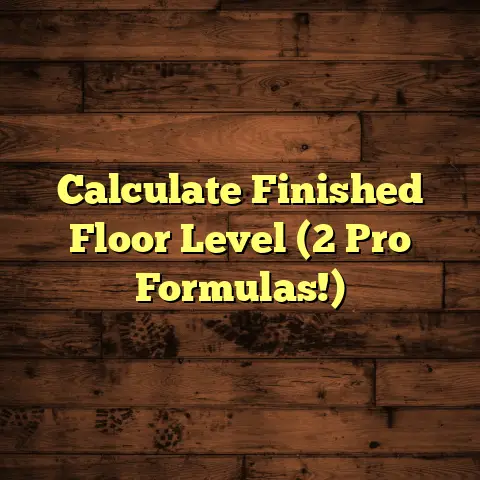Planning A Kitchen? (5 Costly Mistakes!)
Ever dreamt of stepping into a brand-new kitchen, the heart of your home, where culinary masterpieces are created and memories are made? I know I have! The thought of sleek countertops, gleaming appliances, and a space perfectly tailored to your needs is incredibly exciting. You can already imagine hosting unforgettable dinner parties and enjoying countless cozy family meals.
But, let’s be real. Kitchen renovations, while exciting, can quickly turn into a source of stress and financial strain if not approached with a clear plan. I’ve seen it happen time and time again in my years as a flooring contractor. Believe me, the dream can quickly become a nightmare if you stumble into some common, yet costly, pitfalls.
That’s why I’m here to share my expertise and help you avoid these mistakes. Careful planning and consideration are key to creating a kitchen that not only looks amazing but also functions flawlessly and stays within your budget. So, let’s dive in and make sure your dream kitchen doesn’t become a financial headache!
Mistake #1 – Underestimating the Budget
It’s a classic rookie mistake, and honestly, one I’ve even been guilty of myself on personal projects. You get caught up in the excitement, envisioning all the beautiful finishes and high-end appliances, and before you know it, your budget is blown before you even start demo.
The truth is, kitchen renovations are rarely cheap. According to a recent survey by Remodeling Magazine, the national average for a midrange kitchen remodel is over $28,000, while a major upscale remodel can easily exceed $75,000. Whoa, right?
But where does all that money go? Let’s break it down:
- Materials: This includes everything from cabinets and countertops to flooring, backsplash, and paint. These are the things you see and touch, and costs can vary wildly depending on the quality and style you choose.
- Appliances: Refrigerators, ovens, dishwashers, microwaves – these are essential for a functional kitchen, and their prices can range from a few hundred dollars to several thousand per appliance.
- Labor: Hiring skilled professionals like plumbers, electricians, carpenters, and flooring installers is crucial for a successful renovation. Their expertise comes at a cost, but it’s an investment that can save you headaches down the road.
- Unexpected Expenses: This is where things often go wrong. Hidden plumbing issues, electrical problems, structural repairs – these are just a few of the surprises that can pop up during a renovation and wreak havoc on your budget.
I remember one client, Sarah, who was so excited about her new granite countertops that she completely overlooked the cost of installing new electrical outlets to accommodate her upgraded appliances. The unexpected $1,500 expense forced her to compromise on her backsplash, leaving her feeling disappointed with the final result.
So, how do you avoid this common trap?
Here’s my advice for creating a realistic kitchen renovation budget:
- Do Your Research: Start by researching the average costs of different materials and services in your area. Online resources like HomeAdvisor and Angie’s List can provide valuable insights.
- Get Multiple Quotes: Don’t settle for the first contractor you find. Get at least three different quotes to compare pricing and services.
- Be Specific: Provide contractors with detailed information about your project, including the materials you want to use and the scope of the work. This will help them provide more accurate estimates.
- Include a Contingency Fund: This is the most important step! Set aside at least 10-15% of your total budget for unexpected expenses. Trust me, you’ll thank yourself later.
- Prioritize: Decide what’s most important to you in your new kitchen. If you’re on a tight budget, consider splurging on a few key features and saving on others.
By taking the time to create a realistic budget and planning for the unexpected, you can avoid the financial stress and disappointment that can derail a kitchen renovation. Trust me, your wallet will thank you!
Mistake #2 – Ignoring the Kitchen Workflow
Okay, let’s talk about something that might not be as visually exciting as granite countertops, but it’s arguably even more important: kitchen workflow.
What exactly is kitchen workflow? Simply put, it’s the way you move around your kitchen while preparing meals. A well-designed kitchen should allow you to move efficiently between different tasks, minimizing wasted steps and maximizing productivity.
The foundation of good kitchen workflow is the “work triangle,” which is the relationship between your sink, stove, and refrigerator. These are the three most frequently used areas in the kitchen, and they should be arranged in a way that creates a natural flow.
Think about it: you typically grab ingredients from the refrigerator, wash them at the sink, and then cook them on the stove. If these three areas are too far apart or obstructed by obstacles, you’ll be constantly running back and forth, wasting time and energy.
I’ve seen kitchens where the refrigerator is located on the opposite side of the room from the sink, or where the stove is tucked away in a corner, making it difficult to access. These poorly planned layouts can make cooking a frustrating experience.
Here are a few examples of kitchen layouts that optimize workflow:
- The U-Shaped Kitchen: This layout is ideal for maximizing counter space and storage. The sink, stove, and refrigerator can be arranged along the three walls, creating a compact and efficient work triangle.
- The L-Shaped Kitchen: This layout is versatile and works well in both small and large kitchens. The sink and stove can be placed on one leg of the “L,” while the refrigerator is placed on the other.
- The Island Kitchen: An island can add valuable counter space and storage to a kitchen. It can also be used to create a second work zone, such as a prep area or a breakfast bar.
On the other hand, here are some drawbacks of poorly planned designs:
- Islands that are too small or too large: A tiny island is useless, and a huge island can block traffic flow.
- Appliances placed too close together: This can create a cramped and uncomfortable work environment.
- Lack of counter space: Insufficient counter space can make it difficult to prepare meals and can lead to clutter.
So, how do you ensure that your new kitchen has a good workflow?
Here are a few tips:
- Assess Your Cooking Habits: Think about how you typically use your kitchen. Do you cook frequently? Do you entertain often? How many people usually cook at the same time?
- Consider Your Space: Take into account the size and shape of your kitchen. This will help you determine the best layout for your space.
- Think About Traffic Flow: Make sure there’s enough room for people to move around the kitchen without bumping into each other.
- Work with a Designer: A professional kitchen designer can help you create a layout that optimizes workflow and meets your specific needs.
By paying attention to kitchen workflow, you can create a space that’s not only beautiful but also functional and enjoyable to use. Happy cooking!
Mistake #3 – Poor Lighting Choices
Let’s shed some light (pun intended!) on another critical aspect of kitchen design: lighting. I’ve seen kitchens that look stunning in photos but are practically unusable due to poor lighting. Trust me, lighting can make or break a kitchen.
Lighting isn’t just about illuminating the space; it’s about creating the right ambiance, enhancing functionality, and highlighting key features. A well-lit kitchen is a joy to work in, while a poorly lit kitchen can be a source of frustration and even danger.
There are three main types of lighting to consider in your kitchen:
- Ambient Lighting: This is the general, overall lighting that illuminates the entire space. It’s usually provided by overhead fixtures like recessed lights, chandeliers, or pendant lights.
- Task Lighting: This is focused lighting that provides illumination for specific tasks, such as chopping vegetables, reading recipes, or washing dishes. It’s typically provided by under-cabinet lights, pendant lights over the island, or spotlights.
- Accent Lighting: This is decorative lighting that highlights specific features, such as artwork, architectural details, or display shelves. It’s usually provided by spotlights, wall sconces, or strip lighting.
Common lighting mistakes I see all the time:
- Relying Solely on Overhead Fixtures: This is the most common mistake. Overhead fixtures alone can create harsh shadows and leave work areas poorly lit.
- Neglecting Task Lighting: This is especially problematic in kitchens with dark countertops or cabinets. Without adequate task lighting, it can be difficult to see what you’re doing.
- Using the Wrong Type of Bulbs: Different types of bulbs emit different colors of light. Using the wrong type of bulb can make your kitchen feel cold and uninviting.
- Ignoring Dimmers: Dimmers allow you to adjust the brightness of your lights, creating a more flexible and comfortable lighting scheme.
I remember one client, Mark, who installed beautiful new cabinets but failed to add under-cabinet lighting. He quickly realized that he couldn’t see what he was doing when he was chopping vegetables or reading recipes. He ended up having to hire an electrician to install the lights after the fact, which cost him extra money and time.
So, how do you create a balanced lighting scheme that enhances your kitchen experience?
Here are my suggestions:
- Layer Your Lighting: Use a combination of ambient, task, and accent lighting to create a well-lit and visually appealing space.
- Choose the Right Bulbs: Opt for LED bulbs with a warm color temperature (2700-3000K) for a cozy and inviting feel.
- Install Under-Cabinet Lighting: This is essential for providing task lighting to work areas.
- Use Dimmers: Dimmers allow you to adjust the brightness of your lights to suit your needs.
- Consider Natural Light: Maximize natural light by adding windows or skylights.
By paying attention to lighting, you can transform your kitchen from a dark and dreary space into a bright and welcoming one. Let there be light!
Mistake #4 – Skimping on Storage Solutions
Raise your hand if you’ve ever struggled with overflowing cabinets, cluttered countertops, and a general lack of storage space in your kitchen. I see those hands!
Insufficient storage is a common problem in many kitchens, and it can lead to frustration, disorganization, and a general feeling of being overwhelmed. A well-designed kitchen should have ample storage space for all your cookware, utensils, appliances, and food items.
Common storage issues I’ve encountered:
- Overcrowded Countertops: This is a sign that you don’t have enough storage space for your small appliances and utensils.
- Disorganized Cabinets: This can make it difficult to find what you’re looking for and can lead to food waste.
- Wasted Space: Many kitchens have unused space that could be utilized for storage.
- Inaccessible Storage: High shelves or deep cabinets can be difficult to reach, making them less useful.
I worked with a client, Lisa, who had a beautiful kitchen but was constantly complaining about the lack of storage space. Her countertops were always cluttered, and she had to store some of her appliances in the dining room. After we added some custom cabinetry and clever shelving solutions, she was amazed at how much more organized and functional her kitchen became.
So, how do you maximize storage in your kitchen?
Here are some innovative ideas:
- Custom Cabinetry: This is the most effective way to create storage that meets your specific needs. Custom cabinets can be designed to fit your space perfectly and can include features like pull-out shelves, spice racks, and utensil organizers.
- Clever Shelving Solutions: There are many creative shelving solutions that can help you maximize storage space, such as floating shelves, corner shelves, and pull-down shelves.
- Multi-Functional Furniture: Consider adding furniture that serves multiple purposes, such as a kitchen island with built-in storage or a bench with a hidden compartment.
- Vertical Storage: Utilize vertical space by adding tall cabinets or shelving units.
- Drawer Organizers: Drawer organizers can help you keep your drawers neat and tidy, making it easier to find what you’re looking for.
I remember one kitchen we designed where we incorporated a pull-out pantry with adjustable shelves. It allowed the homeowner to easily access all of their canned goods and dry ingredients, eliminating the need for a separate pantry closet.
Here are some case studies of kitchens that successfully integrated storage solutions:
- A small kitchen with limited counter space: We added a pull-out cutting board that could be hidden away when not in use.
- A kitchen with high ceilings: We installed tall cabinets that reached the ceiling, providing ample storage space for less frequently used items.
- A kitchen with a corner cabinet: We added a lazy Susan to make it easier to access items stored in the back of the cabinet.
By investing in smart storage solutions, you can transform your kitchen from a cluttered and disorganized space into a functional and efficient one. A place for everything, and everything in its place!
Mistake #5 – Overlooking Future Needs
Finally, let’s talk about something that’s often overlooked during kitchen planning: future needs. It’s easy to get caught up in the present, focusing on your current lifestyle and cooking habits. But what about the future?
Will your family grow? Will your cooking habits change? Will technology continue to evolve? These are all important questions to consider when planning your kitchen.
I’ve seen homeowners who didn’t plan for future needs and ended up regretting their decisions. For example, a couple who downsized to a smaller home designed a minimalist kitchen with limited counter space. A few years later, they had grandchildren visiting frequently, and they realized that they needed more space for preparing meals.
Family dynamics, cooking habits, and technology can all evolve over time and impact kitchen use. For example:
- Family Dynamics: If you’re planning to start a family, you’ll need to consider the needs of young children, such as a safe and accessible cooking area.
- Cooking Habits: If you’re planning to adopt a healthier lifestyle, you may need more space for preparing fresh fruits and vegetables.
- Technology: As technology continues to evolve, you may want to incorporate smart appliances and other features into your kitchen.
I remember one client, John, who installed a beautiful new kitchen with all the latest appliances. However, he didn’t consider the fact that he might eventually want to sell his home. When he put his house on the market, potential buyers were turned off by the outdated style of the kitchen.
So, how do you plan for future needs?
Here’s my advice:
- Think Long-Term: Consider how your lifestyle and needs might change over the next 5-10 years.
- Incorporate Flexibility: Choose design elements that can be easily adapted to changing needs.
- Plan for Aging in Place: If you plan to stay in your home for many years, consider features that will make it easier to age in place, such as wider doorways and lower countertops.
- Choose Timeless Design: Avoid trendy styles that will quickly become outdated. Opt for classic designs that will stand the test of time.
- Consider Resale Value: Keep in mind that your kitchen is an investment in your home. Choose design elements that will appeal to potential buyers.
By thinking long-term and incorporating flexibility into your design, you can create a kitchen that will meet your needs for years to come. A kitchen that grows with you!
Conclusion
So, there you have it – the five costly mistakes to avoid when planning your kitchen. Underestimating the budget, ignoring the kitchen workflow, poor lighting choices, skimping on storage solutions, and overlooking future needs.
Remember, careful planning is the key to creating a kitchen that not only looks amazing but also functions flawlessly and adds value to your home. A well-thought-out kitchen can enhance your daily life, making cooking and entertaining a joy.
Don’t let the excitement of a new kitchen blind you to the potential pitfalls. Take the time to research, plan, and consult with professionals. By doing so, you can ensure that your dream kitchen becomes a reality, not a financial nightmare.
So, go ahead and start planning your dream kitchen! With a little bit of knowledge and preparation, you can create a space that truly meets your needs and dreams. Happy renovating!





